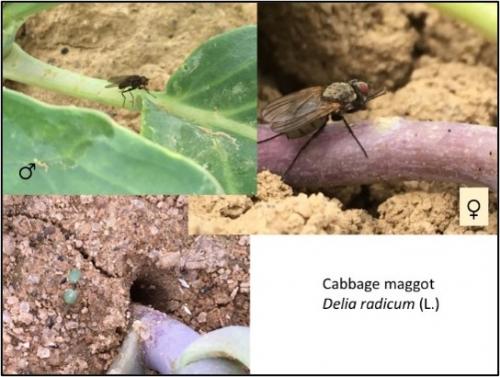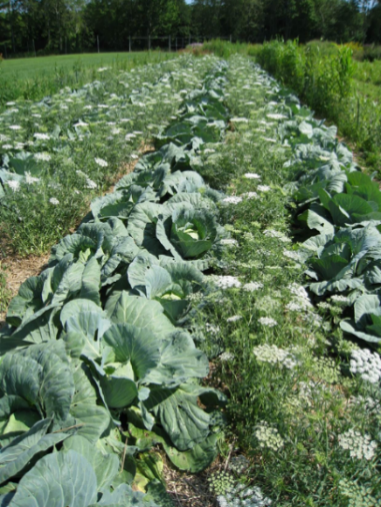Tips & Tricks for Managing Insect Pests of Brassicas
Cabbage Root Maggot
- Rotate locations of spring and fall brassica plantings within and between seasons.
- Predict CRM emergence using indicator plants (flowering yellow rocket), NEWA model, or other monitoring tools.
- Check for signs of infestation: Look at the base of the plants for CRM eggs and check roots for damage.
- Control: Look for alternatives to chlorpyrifos. Verimark is a good choice, and other options are available including Entrust (OMRI-listed) for some crops (check labels, regional restrictions apply).
- Grow your own transplants and treat before setting out or during hardening off.
- Exclusion netting can be used for small-scale or organic producers. It will protect from cabbage maggot and other insects—cabbage and other waxy crops can be grown on black plastic mulch for weed control under exclusion netting.
- Mature plants can withstand some level of root damage.
Caterpillars
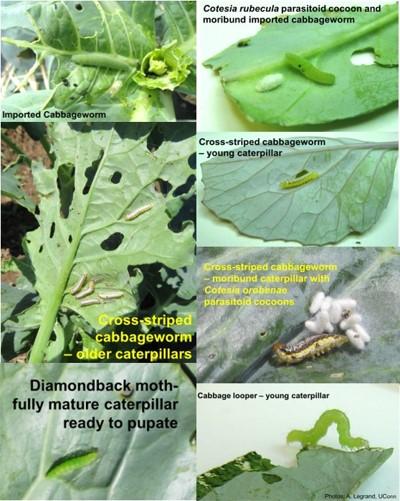 Identify the caterpillar species present to determine proper threshold level and inform choice of insecticide.
Identify the caterpillar species present to determine proper threshold level and inform choice of insecticide.- Grow your own transplants to avoid introducing resistant diamondback moths.
- For small-scale production or hardening off transplants, exclusion netting works great to keep out caterpillars and other pests.
- Include an adjuvant (wetting agent or sticker) to keep spray materials on foliage.
- Do as much as possible to improve spray coverage, especially to get material under foliage and in center growth.
- Start with Bt materials – inexpensive and generally sufficiently effective – rotating to others as needed for larger loopers and other pests like FB.
- Rotate Bt subspecies used (Bt kurstaki or Bt aizawai) for resistance management.
- Check pesticide side effects on beneficial insects like predators and parasitoids. Use selective pesticides.
- Scout weekly, if possible, to re-assess pest status and spray efficacy. Look for eggs (looper, ICW mainly) as well as larvae, to prevent feeding damage from large larvae.
Flea Beetle
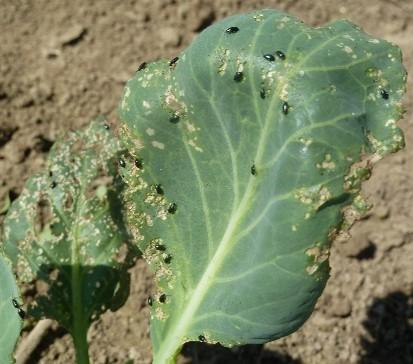
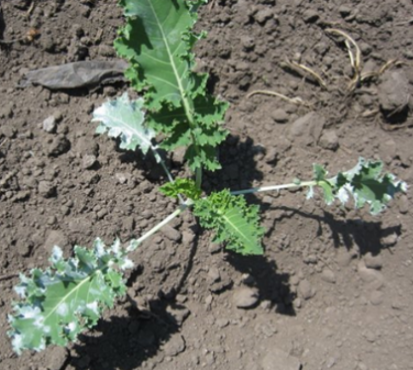 Rotate crop locations, moving spring crops away from fall crops in order to leave FB behind.
Rotate crop locations, moving spring crops away from fall crops in order to leave FB behind.- Use row covers or insect netting in spring and/or for direct-seeded crops.
- Grow larger transplants, which can tolerate more damage.
- Use Surround to protect waxy seedlings during establishment. Mix well, include an adjuvant, and re-apply at least weekly and after rain.
- Conventional: many effective options including diamides (e.g. Exirel, Harvanta), neonicotinoids (e.g. Admire, Platinum, Venom), Sevin XLR, Torac, and pyrethroids.
- Organic: spinsoad (Entrust) is the most effective organic treatment. Pyganic is not effective alone.
- Improve spray coverage: Use an adjuvant (wetting agent or sticker), hollow cone nozzles, and enough spray volume to cover plants.
- Re-apply insecticides as long as FB are present during the susceptible period for that crop (first 2-4 weeks for transplanted waxy crops, or for the life of non-waxy crops).
- Till under residues quickly after harvest, and eradicate weed hosts.
- Use mustard trap crops (or use highly attractive cash crops e.g. bok choy as traps) to reduce spraying. Keep the trap crop healthy and spray the trap crop regularly to be successful.
Cabbage Aphid
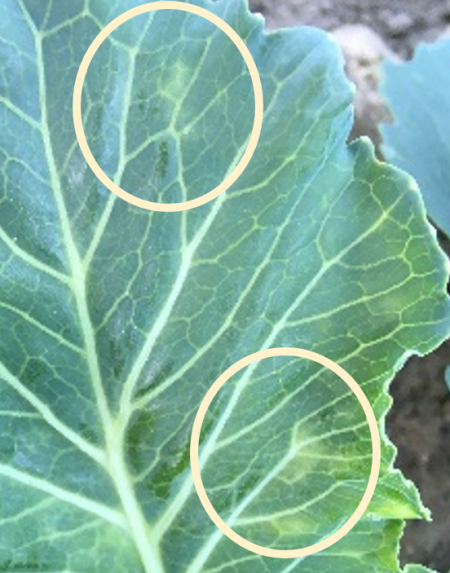
 Rotate crop locations, moving spring crops away from fall crops in order to leave CA behind.
Rotate crop locations, moving spring crops away from fall crops in order to leave CA behind.- Scout regularly for signs of the very first aphids, ESPECIALLY if there were high populations the previous year. Watch for patchy leaf yellowing!
- Rogue out any plants that are severely infested.
- Take action when aphids are first observed: treat with insecticides when 10% or more of the plants have at least one aphid. For organic growers, options include azadirachtin, pyrethrum, and insecticidal soaps, alone or in tank-mixes or rotations. There are many effective conventional insecticide options: https://nevegetable.org/crops/insect-control-3
- After treating, continue scouting on a weekly basis and treating whenever the threshold is exceeded.
- Do as much as possible to improve spray coverage, especially to get material under foliage and in center growth, and include an adjuvant (wetting agent or sticker).
- Incorporate crop residues thoroughly at the end of the season or in very early spring.
Common Themes
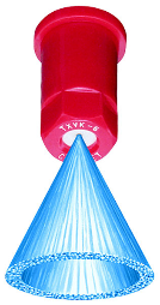
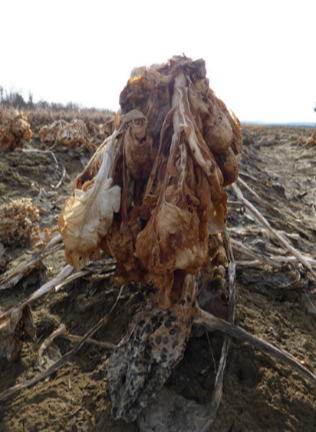 Rotate spring from fall plantings, and fall from spring plantings—leave your worries behind! (for CRM, FB, CA—not caterpillars)
Rotate spring from fall plantings, and fall from spring plantings—leave your worries behind! (for CRM, FB, CA—not caterpillars)- Scout early and often in order to catch problems early, get a proper ID, and keep up with continuous pests. (FB, caterpillars, CA)
- Improve spray coverage: Hollow cone nozzles are recommended for insecticide and fungicide applications. Consider adding drop nozzles for large crops like Brussels sprouts. Always use a spreader and/or sticker to keep spray materials on foliage. (FB, caterpillars, CA)
- Continue treating as long as thresholds are exceeded—one spray will not keep all the caterpillars, or aphids, or flea beetles away.
- Till under residues as soon as possible. Mow if you cannot till in order to start the breakdown process.
Alternatives & Frequent Questions
- Use insectary flowers to attract predators and parasitoids: alyssum, cilantro, dill, and Ammi majus attract both types of biocontrol organisms in New England.
- Mulches may interfere with insect host finding and deter activity and egg-laying of root maggots, flea beetles, and cabbage aphids.
- Beneficial nematodes may kill flea beetle larvae, but will not have a direct impact on damage, as adult beetles will move in from other fields.
Written April 2021
This material is based upon work supported by the National Institute of Food and Agriculture, U.S. Department of Agriculture, through the Northeast Sustainable Agriculture Research and Education program under subaward number LNE18-365.

The Center for Agriculture, Food and the Environment and UMass Extension are equal opportunity providers and employers, United States Department of Agriculture cooperating. Contact your local Extension office for information on disability accommodations. Contact the State Center Director’s Office if you have concerns related to discrimination, 413-545-4800 or see ag.umass.edu/civil-rights-information.

